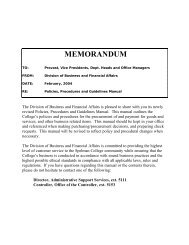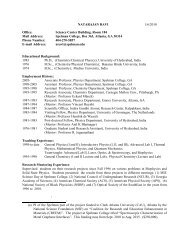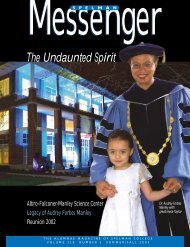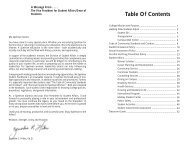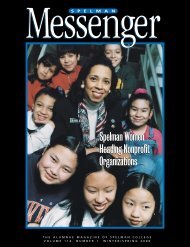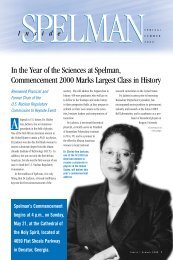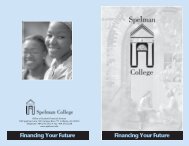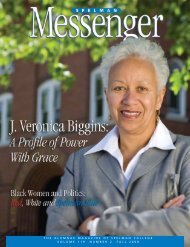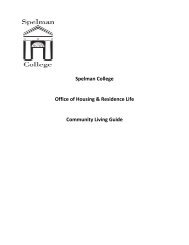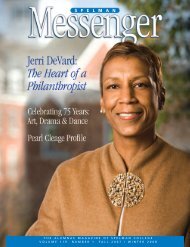(Vol. 114 No. 1) Text (PDF) - Spelman College: Home
(Vol. 114 No. 1) Text (PDF) - Spelman College: Home
(Vol. 114 No. 1) Text (PDF) - Spelman College: Home
- No tags were found...
Create successful ePaper yourself
Turn your PDF publications into a flip-book with our unique Google optimized e-Paper software.
Affairs. This move helped to bridge an emerging nonprofitorganization with a <strong>College</strong> under new leadership.The Association leadership knew that the Associationmust position itself to reduce its dependence on the <strong>College</strong>yet increase its financial strength and clout by puttingitself in the position to obtain independent funding. Theresult was the incorporation of the National AlumnaeAssociation of <strong>Spelman</strong> <strong>College</strong> in 1976 as a 501(c)(3)nonprofit organization as orchestrated by Henrietta Turnquest,C’68, who was the attorney of record for the incorporation.The NAASC was to be a separate corporate entitywhose defined role was to support <strong>Spelman</strong> <strong>College</strong> yetwhich would be self-governing. This led to a shift in theimage of the Association. It was clear that this step was achange in the relationship between NAASC and the <strong>College</strong>.A new NAASC logo was designed and a new imagewas launched. However, the future nature of the newalumnae association was yet to be revealed.The separation was not intented to put the NAASC atodds with the Institution. According to the constitution, theDirector of Alumnae Affairs, an employee of the <strong>College</strong>,was to be the vice-president of the NAASC. Therefore, the<strong>College</strong> would always be aware of the NAASC plans. TheNAASC could present annual reports to the Board ofTrustees. Annual meetings, as required by the articles ofincorporation, would be held on campus in May. PresidentStewart initiated a fundraising campaign that included theNAASC. All of these efforts were carefully planned to answerthe question whether the NAASC was still true to its organizationaland collegiate roots and promises. The differencewas that the NAASC was laying a foundation for the nextmillennium — to clarify roles and identify and communicateneeds — and it was orchestrating a plan of action utilizingcollaborative leadership to meet those needs.Programmatic Initiatives —The SASE ProgramThe <strong>College</strong> faced pressing challenges in the seventies —lowered applications (which threatened the student population),financial pressures and the need for diverse studentexperiences to help students to move beyond the traditionalsocial work, teaching and business careers. The<strong>College</strong> launched an outright effort to attract students inthe sciences for the purpose of producing more scientists,doctors and researchers. The Association responded by collaboratingwith the Admissions Office to recruit studentsfor <strong>Spelman</strong>. In 1976, armed with a manual for alumnae,the Admissions Office held recruitment training sessions totrain alumnae on the latest methods in recruiting students.The NAASC worked with the Office of Career Planning,and the <strong>Spelman</strong> Alumnae-Student Externship(SASE) was started. This program paired alumnae withstudents for a career exploration experience during springbreak. Two separate corporate entities — <strong>Spelman</strong> <strong>College</strong>and the NAASC — were collaborating to meet the needs ofthe students and the Institution.NAASC Scholarships and AwardsThe eighties were the years of visibility and image buildingfor the newly incorporated association. Alumnae wereawarded the first NAASC Hall of Fame Awards and MeritAwards. The <strong>College</strong> recognized several long-term activeAlumnae Association members by naming lounges in theDonald and Isabel Stewart Living Learning Center. TheNAASC established the Donald M. Stewart Endowed Scholarshipwhich provided annual scholarships to students.The National Emergency Student Loan Fund was establishedwith contributions from the Baltimore, Columbia,Washington, D.C. and Los Angeles Chapters. To date, morethan thirty students have borrowed from the EmergencyLoan Fund. The Glee Club had been touring nationally fordecades, the newly organized <strong>Spelman</strong> <strong>College</strong> JazzEnsemble (1987) began touring nationally with the assistanceof the anchor chapters — the Detroit and the<strong>No</strong>rthern New Jersey Chapters. The NAASC, in conjunctionwith the New York Chapter, created its first national raffle,which netted $35,000 for the <strong>College</strong>. In 1981, the NAASCcreated a Landscape Planning Committee that workedwith the School of Environmental Design at the Universityof Georgia to develop a campus beautification campaignfor <strong>Spelman</strong>.Dorothy Pleasant (right),NAASC President ,1982-1986New Jersey Club in the 80’sPhoto: Jo Moore StweartNAASC Meeting, 1980Photo: Jo Moore StweartPhoto: <strong>Spelman</strong> ArchivesW I N T E R / S P R I N G25




